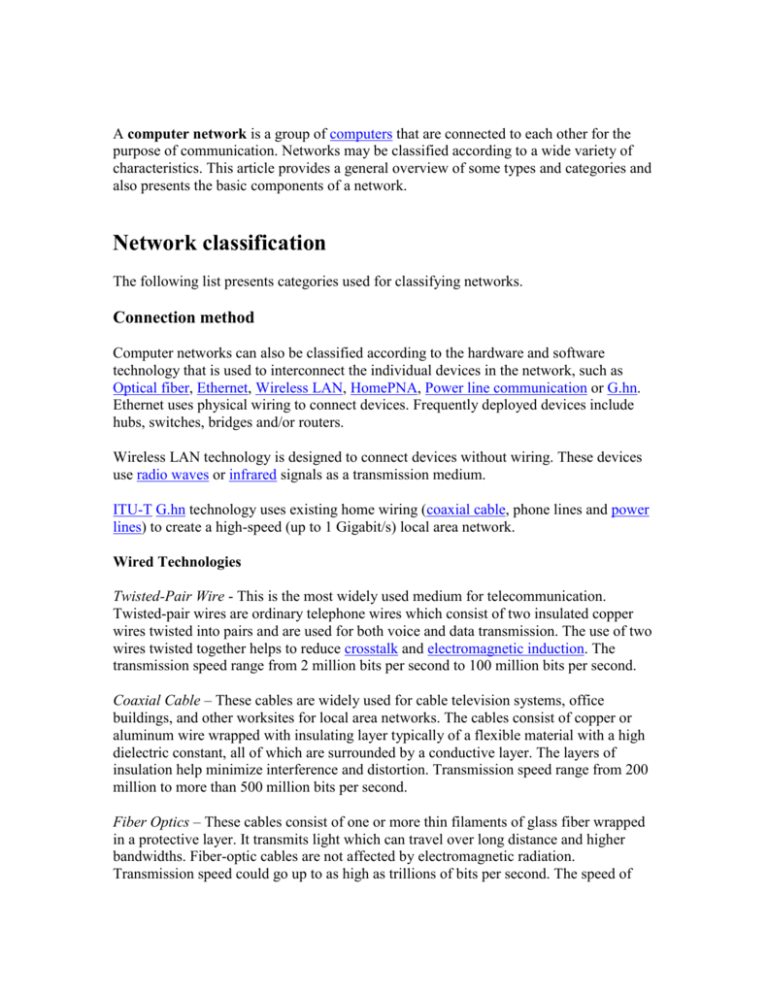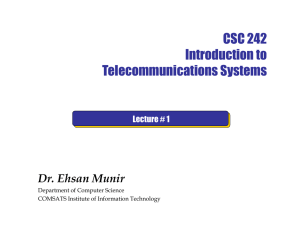19 - Banshi College of Education
advertisement

A computer network is a group of computers that are connected to each other for the purpose of communication. Networks may be classified according to a wide variety of characteristics. This article provides a general overview of some types and categories and also presents the basic components of a network. Network classification The following list presents categories used for classifying networks. Connection method Computer networks can also be classified according to the hardware and software technology that is used to interconnect the individual devices in the network, such as Optical fiber, Ethernet, Wireless LAN, HomePNA, Power line communication or G.hn. Ethernet uses physical wiring to connect devices. Frequently deployed devices include hubs, switches, bridges and/or routers. Wireless LAN technology is designed to connect devices without wiring. These devices use radio waves or infrared signals as a transmission medium. ITU-T G.hn technology uses existing home wiring (coaxial cable, phone lines and power lines) to create a high-speed (up to 1 Gigabit/s) local area network. Wired Technologies Twisted-Pair Wire - This is the most widely used medium for telecommunication. Twisted-pair wires are ordinary telephone wires which consist of two insulated copper wires twisted into pairs and are used for both voice and data transmission. The use of two wires twisted together helps to reduce crosstalk and electromagnetic induction. The transmission speed range from 2 million bits per second to 100 million bits per second. Coaxial Cable – These cables are widely used for cable television systems, office buildings, and other worksites for local area networks. The cables consist of copper or aluminum wire wrapped with insulating layer typically of a flexible material with a high dielectric constant, all of which are surrounded by a conductive layer. The layers of insulation help minimize interference and distortion. Transmission speed range from 200 million to more than 500 million bits per second. Fiber Optics – These cables consist of one or more thin filaments of glass fiber wrapped in a protective layer. It transmits light which can travel over long distance and higher bandwidths. Fiber-optic cables are not affected by electromagnetic radiation. Transmission speed could go up to as high as trillions of bits per second. The speed of fiber optics is hundreds of times faster than coaxial cables and thousands of times faster than twisted-pair wire. Wireless Technologies Terrestrial Microwave – Terrestrial microwaves use Earth-based transmitter and receiver. The equipment look similar to satellite dishes. Terrestrial microwaves use low-gigahertz range, which limits all communications to line-of-sight. Path between relay stations spaced approx. 30 miles apart. Microwave antennas are usually placed on top of buildings, towers, hills, and mountain peaks. Communications Satellites – The satellites use microwave radio as their telecommunications medium which are not deflected by the Earth's atmosphere. The satellites are stationed in space, typically 22,000 miles above the equator. These Earthorbiting systems are capable of receiving and relaying voice, data, and TV signals. Cellular and PCS Systems – Use several radio communications technologies. The systems are divided to different geographic area. Each area has low-power transmitter or radio relay antenna device to relay calls from one area to the next area. Wireless LANs – Wireless local area network use a high-frequency radio technology similar to digital cellular and a low-frequency radio technology. Wireless LANS use spread spectrum technology to enable communication between multiple devices in a limited area. Example of open-standard wireless radio-wave technology is IEEE 802.11b. Bluetooth – A short range wireless technology. Operate at approx. 1Mbps with range from 10 to 100 meters. Bluetooth is an open wireless protocol for data exchange over short distances. The Wireless Web – The wireless web refers to the use of the World Wide Web through equipments like cellular phones, pagers,PDAs, and other portable communications devices. The wireless web service offers anytime/anywhere connection. Scale Networks are often classified as Local Area Network (LAN), Wide Area Network (WAN), Metropolitan Area Network (MAN), Personal Area Network (PAN), Virtual Private Network (VPN), Campus Area Network (CAN), Storage Area Network (SAN), etc. depending on their scale, scope and purpose. Usage, trust levels and access rights often differ between these types of network - for example, LANs tend to be designed for internal use by an organization's internal systems and employees in individual physical locations (such as a building), while WANs may connect physically separate parts of an organization to each other and may include connections to third parties. Functional relationship (network architecture) Computer networks may be classified according to the functional relationships which exist among the elements of the network, e.g., Active Networking, Client-server and Peer-to-peer (workgroup) architecture. Network topology Computer networks may be classified according to the network topology upon which the network is based, such as bus network, star network, ring network, mesh network, starbus network, tree or hierarchical topology network. Network topology signifies the way in which devices in the network see their logical relations to one another. The use of the term "logical" here is significant. That is, network topology is independent of the "physical" layout of the network. Even if networked computers are physically placed in a linear arrangement, if they are connected via a hub, the network has a Star topology, rather than a bus topology. In this regard the visual and operational characteristics of a network are distinct; the logical network topology is not necessarily the same as the physical layout. Networks may be classified based on the method of data used to convey the data, these include digital and analog networks. Types of networks Below is a list of the most common types of computer networks in order of scale. Personal area network A personal area network (PAN) is a computer network used for communication among computer devices close to one person. Some examples of devices that are used in a PAN are personal computers, printers, fax machines, telephones, PDAs, scanners, and even video game consoles. Such a PAN may include wired and wireless connections between devices. The reach of a PAN is typically at least about 20-30 feet (approximately 6-9 meters), but this is expected to increase with technology improvements. Local area network A local Area Network (LAN) is a computer network covering a small physical area, like a home, office, or small group of buildings, such as a school, or an airport. Current wired LANs are most likely to be based on Ethernet technology, although new standards like ITU-T G.hn also provide a way to create a wired LAN using existing home wires (coaxial cables, phone lines and power lines)[2]. For example, a library may have a wired or wireless LAN for users to interconnect local devices (e.g., printers and servers) and to connect to the internet. On a wired LAN, PCs in the library are typically connected by category 5 (Cat5) cable, running the IEEE 802.3 protocol through a system of interconnected devices and eventually connect to the Internet. The cables to the servers are typically on Cat 5e enhanced cable, which will support IEEE 802.3 at 1 Gbit/s. A wireless LAN may exist using a different IEEE protocol, 802.11b, 802.11g or possibly 802.11n. The staff computers (bright green in the figure) can get to the color printer, checkout records, and the academic network and the Internet. All user computers can get to the Internet and the card catalog. Each workgroup can get to its local printer. Note that the printers are not accessible from outside their workgroup. Typical library network, in a branching tree topology and controlled access to resources All interconnected devices must understand the network layer (layer 3), because they are handling multiple subnets (the different colors). Those inside the library, which have only 10/100 Mbit/s Ethernet connections to the user device and a Gigabit Ethernet connection to the central router, could be called "layer 3 switches" because they only have Ethernet interfaces and must understand IP. It would be more correct to call them access routers, where the router at the top is a distribution router that connects to the Internet and academic networks' customer access routers. The defining characteristics of LANs, in contrast to WANs (Wide Area Networks), include their higher data transfer rates, smaller geographic range, and lack of a need for leased telecommunication lines. Current Ethernet or other IEEE 802.3 LAN technologies operate at speeds up to 10 Gbit/s. This is the data transfer rate. IEEE has projects investigating the standardization of 40 and 100 Gbit/s.[3] Campus area network A campus area network (CAN) is a computer network made up of an interconnection of local area networks (LANs) within a limited geographical area. It can be considered one form of a metropolitan area network, specific to an academic setting. In the case of a university campus-based campus area network, the network is likely to link a variety of campus buildings including; academic departments, the university library and student residence halls. A campus area network is larger than a local area network but smaller than a wide area network (WAN) (in some cases). The main aim of a campus area network is to facilitate students accessing internet and university resources. This is a network that connects two or more LANs but that is limited to a specific and contiguous geographical area such as a college campus, industrial complex, office building, or a military base. A CAN may be considered a type of MAN (metropolitan area network), but is generally limited to a smaller area than a typical MAN. This term is most often used to discuss the implementation of networks for a contiguous area. This should not be confused with a Controller Area Network. A LAN connects network devices over a relatively short distance. A networked office building, school, or home usually contains a single LAN, though sometimes one building will contain a few small LANs (perhaps one per room), and occasionally a LAN will span a group of nearby buildings. Metropolitan area network A metropolitan area network (MAN) is a network that connects two or more local area networks or campus area networks together but does not extend beyond the boundaries of the immediate town/city. Routers, switches and hubs are connected to create a metropolitan area network. Wide area network A wide area network (WAN) is a computer network that covers a broad area (i.e. any network whose communications links cross metropolitan, regional, or national boundaries [1]). Less formally, a WAN is a network that uses routers and public communications links. Contrast with personal area networks (PANs), local area networks (LANs), campus area networks (CANs), or metropolitan area networks (MANs), which are usually limited to a room, building, campus or specific metropolitan area (e.g., a city) respectively. The largest and most well-known example of a WAN is the Internet. A WAN is a data communications network that covers a relatively broad geographic area (i.e. one city to another and one country to another country) and that often uses transmission facilities provided by common carriers, such as telephone companies. WAN technologies generally function at the lower three layers of the OSI reference model: the physical layer, the data link layer, and the network layer. Global area network A global area networks (GAN) (see also IEEE 802.20) specification is in development by several groups, and there is no common definition. In general, however, a GAN is a model for supporting mobile communications across an arbitrary number of wireless LANs, satellite coverage areas, etc. The key challenge in mobile communications is "handing off" the user communications from one local coverage area to the next. In IEEE Project 802, this involves a succession of terrestrial WIRELESS local area networks (WLAN).[4] Virtual private network A virtual private network (VPN) is a computer network in which some of the links between nodes are carried by open connections or virtual circuits in some larger network (e.g., the Internet) instead of by physical wires. The data link layer protocols of the virtual network are said to be tunneled through the larger network when this is the case. One common application is secure communications through the public Internet, but a VPN need not have explicit security features, such as authentication or content encryption. VPNs, for example, can be used to separate the traffic of different user communities over an underlying network with strong security features. A VPN may have best-effort performance, or may have a defined service level agreement (SLA) between the VPN customer and the VPN service provider. Generally, a VPN has a topology more complex than point-to-point. A VPN allows computer users to appear to be editing from an IP address location other than the one which connects the actual computer to the Internet. Internetwork An Internetwork is the connection of two or more distinct computer networks or network segments via a common routing technology. The result is called an internetwork (often shortened to internet). Two or more networks or network segments connect using devices that operate at layer 3 (the 'network' layer) of the OSI Basic Reference Model, such as a router. Any interconnection among or between public, private, commercial, industrial, or governmental networks may also be defined as an internetwork. In modern practice, interconnected networks use the Internet Protocol. There are at least three variants of internetworks, depending on who administers and who participates in them: Intranet Extranet Internet Intranets and extranets may or may not have connections to the Internet. If connected to the Internet, the intranet or extranet is normally protected from being accessed from the Internet without proper authorization. The Internet is not considered to be a part of the intranet or extranet, although it may serve as a portal for access to portions of an extranet. Intranet An intranet is a set of networks, using the Internet Protocol and IP-based tools such as web browsers and file transfer applications, that is under the control of a single administrative entity. That administrative entity closes the intranet to all but specific, authorized users. Most commonly, an intranet is the internal network of an organization. A large intranet will typically have at least one web server to provide users with organizational information. Extranet An extranet is a network or internetwork that is limited in scope to a single organization or entity but which also has limited connections to the networks of one or more other usually, but not necessarily, trusted organizations or entities (e.g., a company's customers may be given access to some part of its intranet creating in this way an extranet, while at the same time the customers may not be considered 'trusted' from a security standpoint). Technically, an extranet may also be categorized as a CAN, MAN, WAN, or other type of network, although, by definition, an extranet cannot consist of a single LAN; it must have at least one connection with an external network. Internet The Internet consists of a worldwide interconnection of governmental, academic, public, and private networks based upon the networking technologies of the Internet Protocol Suite. It is the successor of the Advanced Research Projects Agency Network (ARPANET) developed by DARPA of the U.S. Department of Defense. The Internet is also the communications backbone underlying the World Wide Web (WWW). The 'Internet' is most commonly spelled with a capital 'I' as a proper noun, for historical reasons and to distinguish it from other generic internetworks. Participants in the Internet use a diverse array of methods of several hundred documented, and often standardized, protocols compatible with the Internet Protocol Suite and an addressing system (IP Addresses) administered by the Internet Assigned Numbers Authority and address registries. Service providers and large enterprises exchange information about the reachability of their address spaces through the Border Gateway Protocol (BGP), forming a redundant worldwide mesh of transmission paths. Basic hardware components All networks are made up of basic hardware building blocks to interconnect network nodes, such as Network Interface Cards (NICs), Bridges, Hubs, Switches, and Routers. In addition, some method of connecting these building blocks is required, usually in the form of galvanic cable (most commonly Category 5 cable). Less common are microwave links (as in IEEE 802.12) or optical cable ("optical fiber"). An Ethernet card may also be required. Network interface cards A network card, network adapter, or NIC (network interface card) is a piece of computer hardware designed to allow computers to communicate over a computer network. It provides physical access to a networking medium and often provides a low-level addressing system through the use of MAC addresses. Repeaters A repeater is an electronic device that receives a signal and retransmits it at a higher power level, or to the other side of an obstruction, so that the signal can cover longer distances without degradation. In most twisted pair Ethernet configurations, repeaters are required for cable which runs longer than 100 meters. Hubs A network hub contains multiple ports. When a packet arrives at one port, it is copied unmodified to all ports of the hub for transmission. The destination address in the frame is not changed to a broadcast address.[5] Bridges A network bridge connects multiple network segments at the data link layer (layer 2) of the OSI model. Bridges do not promiscuously copy traffic to all ports, as hubs do, but learn which MAC addresses are reachable through specific ports. Once the bridge associates a port and an address, it will send traffic for that address only to that port. Bridges do send broadcasts to all ports except the one on which the broadcast was received. Bridges learn the association of ports and addresses by examining the source address of frames that it sees on various ports. Once a frame arrives through a port, its source address is stored and the bridge assumes that MAC address is associated with that port. The first time that a previously unknown destination address is seen, the bridge will forward the frame to all ports other than the one on which the frame arrived. Bridges come in three basic types: 1. Local bridges: Directly connect local area networks (LANs) 2. Remote bridges: Can be used to create a wide area network (WAN) link between LANs. Remote bridges, where the connecting link is slower than the end networks, largely have been replaced with routers. 3. Wireless bridges: Can be used to join LANs or connect remote stations to LANs Switches A network switch is a device that forwards and filters OSI layer 2 datagrams (chunk of data communication) between ports (connected cables) based on the MAC addresses in the packets.[6] This is distinct from a hub in that it only forwards the packets to the ports involved in the communications rather than all ports connected. Strictly speaking, a switch is not capable of routing traffic based on IP address (OSI Layer 3) which is necessary for communicating between network segments or within a large or complex LAN. Some switches are capable of routing based on IP addresses but are still called switches as a marketing term. A switch normally has numerous ports, with the intention being that most or all of the network is connected directly to the switch, or another switch that is in turn connected to a switch.[7] Switch is a marketing term that encompasses routers and bridges, as well as devices that may distribute traffic on load or by application content (e.g., a Web URL identifier). Switches may operate at one or more OSI model layers, including physical, data link, network, or transport (i.e., end-to-end). A device that operates simultaneously at more than one of these layers is called a multilayer switch. Overemphasizing the ill-defined term "switch" often leads to confusion when first trying to understand networking. Many experienced network designers and operators recommend starting with the logic of devices dealing with only one protocol level, not all of which are covered by OSI. Multilayer device selection is an advanced topic that may lead to selecting particular implementations, but multilayer switching is simply not a realworld design concept. Routers A router is a networking device that forwards packets between networks using information in protocol headers and forwarding tables to determine the best next router for each packet. Routers work at the Network Layer of the OSI model and the Internet Layer of TCP/IP. A topology describes the configuration of a communication network. The way in which the elements of a network are mapped or arranged is known as a network topology. A topology describes the physical and the logical interconnection between the different nodes of a network. Network topologies are classified as physical, logical and signal topologies. A physical topology describes the mapping of the network nodes and the physical connections between them. Signal topology describes the paths, which the signals take while they pass over the network. The mapping of the paths taken by data as they travel over the network is known as a logical topology. The terms, signal topology and logical topology are closely related. Let us see the different types of network topologies in detail. Types of Network Topologies Bus Topology: In this type of network topology, all the nodes of a network are connected to a common transmission medium having two endpoints. All the data that travels over the network is transmitted through a common transmission medium known as the bus or the backbone of the network. When the transmission medium has exactly two endpoints, the network topology is known by the name, ‘linear bus topology'. In case the transmission medium, also called as the network backbone, has more than two endpoints, the network is said to have a distributed bus topology. Bus topology is easy to handle and implement and is best suited for small networks. But the downside of this topology is that the limited cable length limits the number of stations, thus limiting the performance to a less number of nodes. Ring Topology: In a ring topology, every node in the network is connected to two other nodes and the first and the last nodes are connected to each other. The data that are transmitted over the network pass through each of the nodes in the ring until they reach the destination node. In a ring network, the data and the signals that pass over the network travel in a single direction. The dual ring topology varies in having two connections between each of the network nodes. The data flow along two directions in the two rings formed thereby. The ring topology does not require a central server to manage connectivity between the nodes and facilitates an orderly network operation. But, the failure of a single station in the network can render the entire network inoperable. Changes and moves in the stations forming the network affect the network operation. Mesh Topology: In a full mesh network, each network node is connected to every other node in the network. Due to this arrangement of nodes, it becomes possible for a simultaneous transmission of signals from one node to several other nodes. In a partially connected mesh network, only some of the network nodes are connected to more than one node. This is beneficial over a fully connected mesh in terms of redundancy caused by the point-to-point links between all the nodes. The nodes of a mesh network require possessing some kind of routing logic so that the signals and the data traveling over the network take the shortest path during each of the transmissions. Star Topology: In this type of network topology, each node of the network is connected to a central node, which is known as a hub. The data that is transmitted between the network nodes passes across the central hub. A distributed star is formed by the interconnection of two or more individual star networks. The centralized nature of a star network provides a certain amount of simplicity while also achieving isolation of each device in the network. However, the disadvantage of a star topology is that the network transmission is largely dependent on the central hub. The failure of the central hub results in total network inoperability. Tree Topology: It is also known as a hierarchical topology and has a central root node that is connected to one or more nodes of a lower hierarchy. In a symmetrical hierarchy, each node in the network has a specific fixed number of nodes connected to those at a lower level. Apart from these basic types of network topologies, there are hybrid network topologies, which are composed of a combination of two or more basic topologies. These network mappings aim at harnessing the advantages of each of the basic topologies used in them. Network topologies are the physical arrangements of network nodes and wires. What is interesting is that the inanimate nodes and wires turn 'live' for the transmission of information! The Internet is a global system of interconnected computer networks that use the standard Internet Protocol Suite (TCP/IP) to serve billions of users worldwide. It is a network of networks that consists of millions of private and public, academic, business, and government networks of local to global scope that are linked by a broad array of electronic and optical networking technologies. The Internet carries a vast array of information resources and services, most notably the inter-linked hypertext documents of the World Wide Web (WWW) and the infrastructure to support electronic mail. Most traditional communications media, such as telephone and television services, are reshaped or redefined using the technologies of the Internet, giving rise to services such as Voice over Internet Protocol (VoIP) and IPTV. Newspaper publishing has been reshaped into Web sites, blogging, and web feeds. The Internet has enabled or accelerated the creation of new forms of human interactions through instant messaging, Internet forums, and social networking sites. The origins of the Internet reach back to the 1960s when the United States funded research projects of its military agencies to build robust, fault-tolerant and distributed computer networks. This research and a period of civilian funding of a new U.S. backbone by the National Science Foundation spawned worldwide participation in the development of new networking technologies and led to the commercialization of an international network in the mid 1990s, and resulted in the following popularization of countless applications in virtually every aspect of modern human life. As of 2009, an estimated quarter of Earth's population uses the services of the Internet. The Internet has no centralized governance in either technological implementation or policies for access and usage; each constituent network sets its own standards. Only the overreaching definitions of the two principal name spaces in the Internet, the Internet Protocol address space and the Domain Name System, are directed by a maintainer organization, the Internet Corporation for Assigned Names and Numbers (ICANN). The technical underpinning and standardization of the core protocols (IPv4 and IPv6) is an activity of the Internet Engineering Task Force (IETF), a non-profit organization of loosely-affiliated international participants that anyone may associate with by contributing technical expertise. The World Wide Web is a system of interlinked hypertext documents contained on the Internet. With a web browser, one can view web pages that may contain text, images, videos, and other multimedia and navigate between them using hyperlinks. Using concepts from earlier hypertext systems, English physicist Sir Tim Berners-Lee, now the Director of the World Wide Web Consortium, wrote a proposal in March 1989 for what would eventually become the World Wide Web.[1] He was later joined by Belgian computer scientist Robert Cailliau while both were working at CERN in Geneva, Switzerland. In 1990, they proposed using "HyperText [...] to link and access information of various kinds as a web of nodes in which the user can browse at will",[2] and released that web in December.[3] "The World-Wide Web (W3) was developed to be a pool of human knowledge, which would allow collaborators in remote sites to share their ideas and all aspects of a common project." [4] If two projects are independently created, rather than have a central figure make the changes, the two bodies of information could form into one cohesive piece of work. File Transfer Protocol (FTP) is a standard network protocol used to exchange and manipulate files over a TCP/IP based network, such as the Internet. FTP is built on a client-server architecture and utilizes separate control and data connections between the client and server applications. Client applications were originally interactive commandline tools with a standardized command syntax, but graphical user interfaces have been developed for all desktop operating systems in use today. FTP is also often used as an application component to automatically transfer files for program internal functions. FTP can be used with user-based password authentication or with anonymous user access. The Trivial File Transfer Protocol (TFTP) is a similar, but simplified, not interoperable, and unauthenticated version of FTP. Telnet (teletype network) is a network protocol used on the Internet or local area networks to provide a bidirectional interactive communications facility. Typically, telnet provides access to a command-line interface on a remote host via a virtual terminal connection which consists of an 8-bit byte oriented data connection over the Transmission Control Protocol (TCP). User data is interspersed in-band with TELNET control information. Telnet was developed in 1969 beginning with RFC 15, extended in RFC 854, and standardized as Internet Engineering Task Force (IETF) Internet Standard STD 8, one of the first Internet standards. The term telnet may also refer to the software that implements the client part of the protocol. Telnet client applications are available for virtually all computer platforms. Most network equipment and operating system with a TCP/IP stack support a Telnet service for remote configuration (including systems based on Windows NT). Because of security issues with Telnet, its use has waned in favor of SSH for remote access. Telnet is also used as a verb. To telnet means to establish a connection with the Telnet protocol, either with command line client or with a programmatic interface. For example, a common directive might be: "To change your password, telnet to the server, login and run the password command." Most often, a user will be telnetting to a Unix-like server system or a network device such as a router and obtain a login prompt to a command line text interface or a character-based full-screen manager. On many systems, a Telnet client application may also be used to establish interactive raw-TCP sessions. It is commonly believed that a Telnet session which does not use the IAC (character 255) is functionally identical.[citation needed] This is not the case, however, because there are other network virtual terminal (NVT) rules, such as the requirement for a bare carriage return character (CR, ASCII 13) to be followed by a NULL (ASCII 0) character, that distinguish the telnet protocol from raw-TCP sessions.







